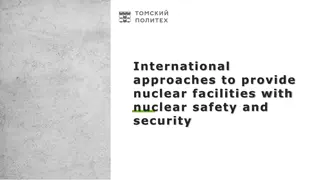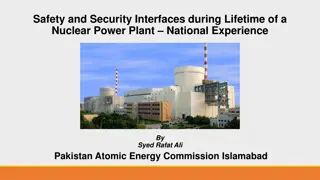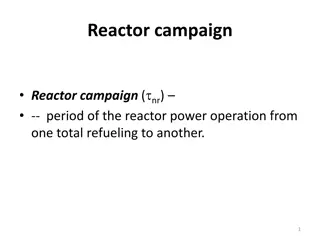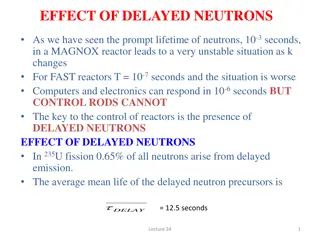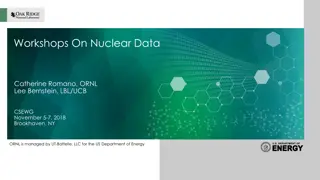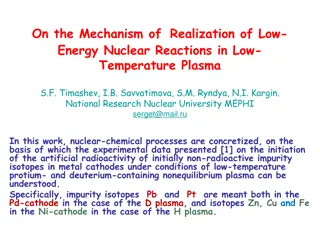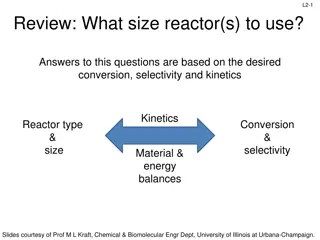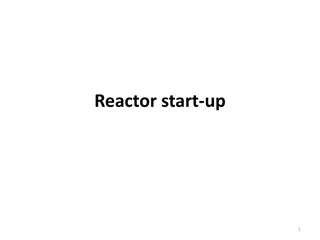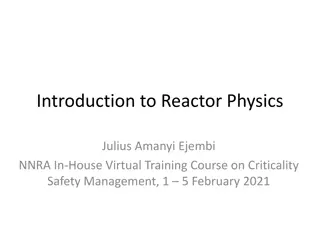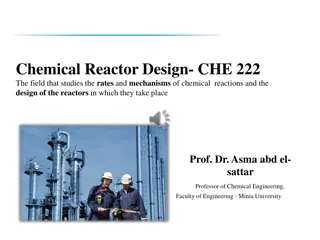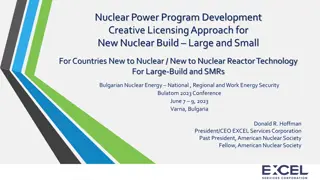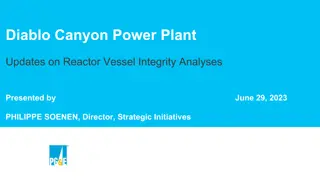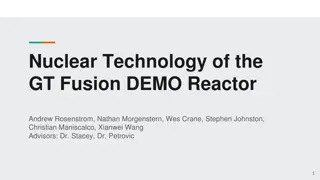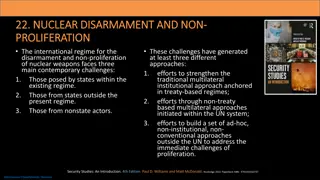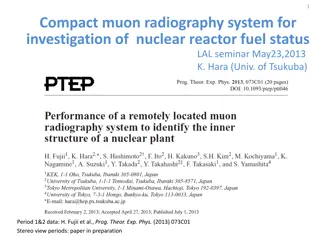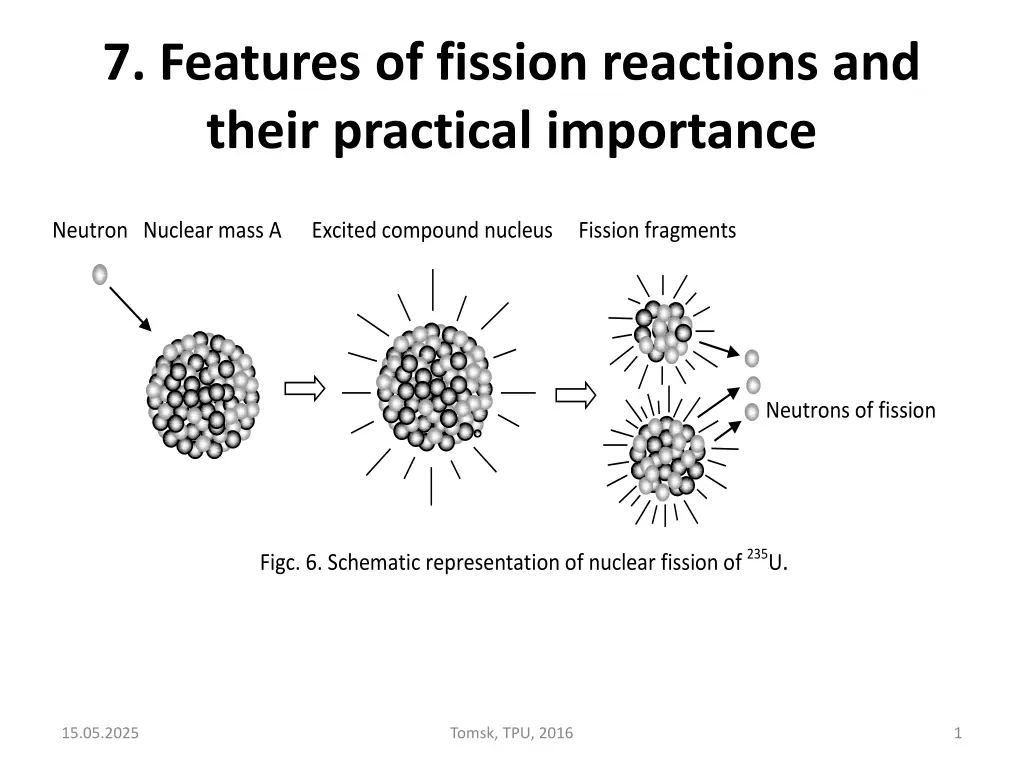
Understanding Features of Fission Reactions and Their Practical Importance
Explore the key aspects of fission reactions, including neutron nuclear mass, excited compound nucleus, fission fragments, and more, with practical implications discussed. Learn about the formation of fission fragments, neutron release, energy production, and the division of heavy uranium nuclei. Dive into the specific yields of fission fragments and the patterns observed in mass division during nuclear fission events.
Download Presentation

Please find below an Image/Link to download the presentation.
The content on the website is provided AS IS for your information and personal use only. It may not be sold, licensed, or shared on other websites without obtaining consent from the author. If you encounter any issues during the download, it is possible that the publisher has removed the file from their server.
You are allowed to download the files provided on this website for personal or commercial use, subject to the condition that they are used lawfully. All files are the property of their respective owners.
The content on the website is provided AS IS for your information and personal use only. It may not be sold, licensed, or shared on other websites without obtaining consent from the author.
E N D
Presentation Transcript
7. Features of fission reactions and their practical importance Neutron Nuclear mass Excited compound nucleus Fission fragments Neutrons of fission Fig . 6. Schematic representation of nuclear fission of 235U. 15.05.2025 Tomsk, TPU, 2016 1
Based on this scheme, a generalized "equation" of the fission reaction can be written as: where: - (F1)* and (F2)* - symbols of the excited fission fragments (index denotes unstable, excited or radioactive elements are marked as (*) ); - 5.1n - 5of neutron fission, released on average, in each event of nuclear fission of 235U; - , and - -particles, -particles and -quanta, average numbers of which per nuclear fission event of 235U are equal to a, b and c, respectively; E - average amount of energy released in the fission event. 235U + 1n (236U)* (F1)* + (F2)* + 5 . 1n + a + b + c + E 15.05.2025 Tomsk, TPU, 2016 2
Expression, written above, reflects the main features of neutron fission reaction: a) formation of fission fragments; b) formation of new free neutrons in fission, which will be briefly called fission neutrons; c) radioactivity of the fission fragments, responsible for their further transformation to more stable formations, which is why there is a number of side effects - both positive, beneficial and negative; d) release of energy in the fission - the main feature of the fission reaction allowing to make a nuclear power reactor. 15.05.2025 Tomsk, TPU, 2016 3
8. Formation of fission fragments Heavy uranium nucleus, consisting of 92 protons and 143 neutrons, can be divided into different number of fragments with different atomic masses. The probability of fission into two fragments is more than 98%, therefore, the vast majority of fissions is completed by the formation of two fragments. More than 600 qualitatively different fission fragments with different atomic masses were determined by spectrascopic studies of fission products. 15.05.2025 Tomsk, TPU, 2016 4
Here, with a large number of fissions there is a common pattern, which can be expressed as follows: The probability of occurrence of a fragment with a specific atomic mass in the mass division of the specific nuclide - strictly defined value inherent in fissile nuclides. This value is referred to as specific yield of the fragment, denoted by small Greek letter i(gamma) with a subscript - a symbol of the chemical element, the nucleus of which is this fragment, or a symbol of the isotope. 15.05.2025 Tomsk, TPU, 2016 5
For example, in physical experiments it is recorded that in the implementation of each of thousands of nuclear fission of 235U, 135Xe fragment appears on average in the three cases. This means that specific yield of 135Xe fragment is Xe= 3/1000 = 0.003 of all divisions. Curves of specific yield of the fragments show clear assessment of the formation of fission fragments of different atomic masses. 15.05.2025 Tomsk, TPU, 2016 6
Fig. 2.7 Specific yields of fission fragments of different atomic masses in nuclear fission of 235U (solid line) and 239Pu (dashed line) 15.05.2025 Tomsk, TPU, 2016 7
The nature of these curves allows to conclude the following: a) The atomic mass of the fragments resulting from the fission, in most cases, are in the range of 70 165 a.m.u. Specific yield of other fragments is very small (no more than 10-4 %). 15.05.2025 Tomsk, TPU, 2016 8
b) Symmetrical nuclear fission (i.e. division into two fragments with equal masses) are extremely rare: their specific yield does not exceed 0.01% for the nuclei of 235U and 0.04% - for the nuclei of 239Pu. c) The most common cases are the formation of small fragments with mass numbers in the range of 83 104 a.m.u. and heavy fragments with A = 128 149 a.m.u. (their specific yield is 1% or more). 15.05.2025 Tomsk, TPU, 2016 9
Fission fragments generated in fission have high kinetic energies. Transmitting its kinetic energy in collisions with atoms of the medium, they increase the average level of kinetic energy of atoms and molecules that, in accordance with the concepts of kinetic theory, is perceived by us as an increase in temperature. Most of the heat in the reactor is formed in this way. 15.05.2025 Tomsk, TPU, 2016 10
9. Formation of fission neutrons The key physical phenomenon accompanying the process of fission of heavy nuclei is the emission of secondary fast neutrons (by excited fission fragments) also known as prompt neutrons or fission neutrons. Due to this in the fission of heavy nuclei new free neutrons appear to replace those that have caused division. 15.05.2025 Tomsk, TPU, 2016 11
These new neutrons can interact with other fissile nuclei in the fuel and cause their fission accompanied by the emission of new fission neutrons. Because of the formation of fission neutrons, it is possible to organize fission process evenly following one after another, without supplying free neutrons from an external source to the fuel-containing medium. 15.05.2025 Tomsk, TPU, 2016 12
Due to the excited state of the fission fragments, they give off "extra" neutrons from the structure, preventing their stability. This occurs during the 10-15 - 10-13s, which coincides with the residence time of the compound nucleus in the excited state. 15.05.2025 Tomsk, TPU, 2016 13
This coincidence gave rise to ideas that fission neutrons do not appear from the excited fission fragments supersaturated by neutrons but in the fission of the nucleus itself. Each fragment in a large number of fissions has a strictly defined specific yield. In a large number of fissions the number of formed fission fragments of each type will also be defined. 15.05.2025 Tomsk, TPU, 2016 14
Consequently, the number of fission neutrons emitted by fragments of each type will be also defined and, therefore, their total number will be defined. The average number of fission neutrons emitted per fission should also be strictly defined and constant for each type of fissile nuclides. This physical constant of fissile nuclide is marked . 15.05.2025 Tomsk, TPU, 2016 15
The value of this constant is periodically updated. It is believed that in the fission by thermal neutrons value : - for uranium -235 5= 2.425, - for plutonium -239 9= 2.862, - for plutonium -241 1= 2.938. 15.05.2025 Tomsk, TPU, 2016 16
The value of constant depends essentially on kinetic energy of neutrons causing fission and with the growth of the latter increases approximately in direct proportion to E. For the two most important fissile nuclides, approximate dependences (E) are described by the empirical expressions: - for uranium-235 5(E) = 2.425 + 0.1337* ; - for plutonium-239 9(E) = 2.862 +0.1357*E. 15.05.2025 Tomsk, TPU, 2016 17
Thus, the value of constant calculated by these empirical formulas for different neutron energies can reach the following values: , MeV Value 5 Value 9 1 5 10 3.746 4.212 2.549 2.997 3.081 3.537 15.05.2025 Tomsk, TPU, 2016 18
For all of fissile nuclides >1. This creates the preconditions for the feasibility of the neutron chain fission reaction. It is clear that to implement a self-sustaining fission chain reaction it is necessary to create conditions when one of produced in fission neutrons necessarily cause the following fission of another nucleus , and the rest ( - 1) neutrons are somehow excluded from the process of nuclear fission. 15.05.2025 Tomsk, TPU, 2016 19
Otherwise, fission rate will grow like an avalanche. It takes place in the atomic bomb. The second characteristic of fission neutrons is called energy spectrum of fission neutrons. It is a function of the distribution of fission neutrons by their kinetic energy. If in unit (1 cm3) volume of the medium at some given moment of time there are n of fission neutrons of all possible energies, normalized energy spectrum - is a function of energy E. 15.05.2025 Tomsk, TPU, 2016 20
Value n(E) for any particular value E shows what part (share) of all these neutrons make neutrons with energies of the elementary interval dE near energy E. The distribution of fission neutrons by energies is fairly accurately described by Watt spectral function: n(E) = 0.4839 exp( ) 2 E sh E 15.05.2025 Tomsk, TPU, 2016 21
Watt spectral function: 15.05.2025 Tomsk, TPU, 2016 22
Watt spectrum shows that, although, fission neutrons are born with a variety of energies lying in a very wide range, most of the neutrons have initial energy equal to Emost probable= 0.7104 MeV, corresponding to maximum of Watt spectral function. This value - the most probable energy of fission neutrons. 15.05.2025 Tomsk, TPU, 2016 23
Another value that characterizes energy spectrum of fission neutrons - average energy of fission neutrons that is the amount of energy that each fission neutron would have if all real total energy of all fission neutrons was equally divided between them: 15.05.2025 Tomsk, TPU, 2016 24
The value of average energy of fission neutrons average = 2.0 MeV. This means that almost all fission neutrons are born fast, with energies E> 0.1 MeV. However, there are less than 1% of fast neutrons with relatively high kinetic energies (more than 7 MeV). But a sizeable number of fission neutrons are with energies to 18 MeV. 15.05.2025 Tomsk, TPU, 2016 25
10. Radioactivity of fission fragments More than 600 types of fission fragments has been established. They differ in mass and proton charge. Almost all of them are born greatly excited. In its natural desire for stability, they "dump" excess energy until the level of the basic stable state will be reached. 15.05.2025 Tomsk, TPU, 2016 26
This dump is carried out by successive emission of all types of radiation (alpha, beta and gamma radiation) by fragments. Different fragments have different kinds of radioactive decay in a different order and they are extended to different degrees in time. 15.05.2025 Tomsk, TPU, 2016 27
Thus, in an operating nuclear reactor, there is not only accumulation of radioactive fragments but a process of their continuous transformation. Therefore, radioactive radiations not only accompanies fission reaction in the operating reactor, but they are emitted by the fuel after its shutdown for a long time. 15.05.2025 Tomsk, TPU, 2016 28
This factor creates a special kind of physical danger - danger of personnel exposure servicing a reactor facility, briefly called radiation hazard. Because of this, the reactor facility is surrounded by biological shielding. 15.05.2025 Tomsk, TPU, 2016 29
After reactor shutdown all kinds of radiation, although decreasing in intensity, continue to interact with the material of the core and transfer their kinetic energy to the atoms of the core medium, increasing average kinetic energy. That is, in the reactor after its shutdown afterheat takes place. 15.05.2025 Tomsk, TPU, 2016 30
Afterheat power in the reactor at the time of shutdown is directly proportional to the amount of fragments accumulated during reactor operation to this moment, and the rate of its decrease in the future is determined by the half-lives of these fragments. 15.05.2025 Tomsk, TPU, 2016 31
There is one more negative factor caused by radioactivity of fission fragments - the need for a long core cooldown after its shutdown to remove afterheat. There is a positive aspect in the transformation of radioactive fission fragments, through which nuclear reactors owe their existence. 15.05.2025 Tomsk, TPU, 2016 32
The fact that of a large number of fission fragments there are approximately 60 fragments that after the first -decay become neutron active, they are capable of emitting so-called delayed neutrons. Relatively few (0.64% of the total number of generated neutrons) delayed neutrons are emitted in the reactor. Due to their existence, safe operation of a nuclear reactor is possible. 15.05.2025 Tomsk, TPU, 2016 33
15.05.2025 Tomsk, TPU, 2016 34

